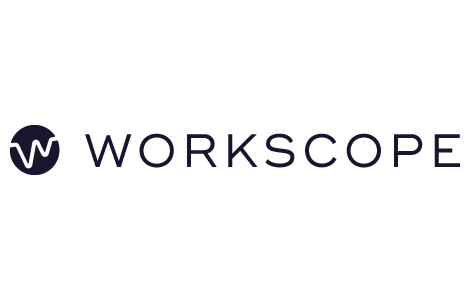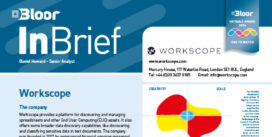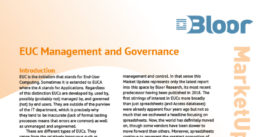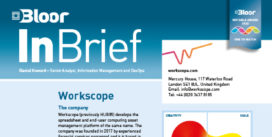Workscope
Last Updated:
Analyst Coverage: Daniel Howard and Philip Howard
Workscope (previously HUB85) develops the spreadsheet and end-user computing asset management platform of the same name. The company was founded in 2017 by experienced financial services personnel and it is based in London, UK, but with clients in both mainland Europe and North America. It has recently received a strategic investment from Alteryx.
Workscope
Last Updated: 15th May 2024
Mutable Award: One to Watch 2024
Workscope is an EUC asset management platform that leverages its Discovery, Governance, and Analysis modules to help you identify, manage, and transform your EUC assets and minimise (or even eliminate) the associated operational risk. As part of this capability, it offers continuous discovery and real-time insights. It also incorporates proprietary machine learning and generative AI into several of its capabilities. The platform offers detailed diagnostics on Excel spreadsheets and Access Databases, while its discovery capabilities can also apply to various other types of assets (such as, but not limited to, Python and R files, Alteryx workflows, and PDFs). Sensitive data discovery and classification are available for text-based documents.
The product’s raison d’être is to provide you with targeted intelligence about your EUC assets that enables you to remediate, manage, and control them effectively. For instance, it offers risk information and usage analysis for your spreadsheets, allowing you to both see which spreadsheets need to be remediated and prioritise that remediation. Moreover, these insights are provided in real-time, allowing you to act on them the moment they become relevant. This is significant compared to rival offerings in this space that do not offer such immediacy. As a further bonus, it enables you to run an automated governance process which dynamically adjusts to new risks as they emerge, helping to maintain operational resilience and making it easy to demonstrate (to a regulating body, say) that your system fulfils regulatory requirements and operates at an acceptably low level of risk.
The platform can be deployed in-cloud or on-prem, and is available via the Azure marketplace. It is containerised via Docker as part of its standard deployment, and it can be consumed via an API. Its hosting and architecture are built on Microsoft infrastructure, while its AI capabilities rely on OpenAI Large Language Models (LLMs). The latter can be leveraged via either a ringfenced Workscope OpenAI instance or a homegrown OpenAI model.
Customer Quotes
“The Workscope platform will be valuable for organisations looking to accelerate insights across their complex data landscape and increase productivity.”
Alteryx
Workscope’s Discovery module automatically discovers and inventories your EUC assets across both networks and desktops, in real time, including assets that may not already be known or visible to you. It then assesses these assets, running a full diagnostic on each file and identifying its structure, data lineage, resource-usage, potential formula errors, and so on, allowing you to remediate based on these factors.
In this way, it discovers both EUC assets themselves and the risk associated with them. It will also identify sensitive data within your EUC assets and text documents, including PII (Personally Identifiable Information), health information, and payment information, as defined by various compliance regulations.
This discovery process acts continuously and in real-time, with or without using agents, and can therefore drive remediating actions in real-time. This is a notable differentiator: many other suppliers in this space only capture changes or additions on a scheduled, rather than a continuous, basis. The platform also analyses how files are being used, providing an additional layer of visibility that delivers insights into how operational processes are happening on the ground. This can be used, for example, to assess the potential ROI for process transformation.
The end result is that Workscope constantly monitors all of your EUC assets, handles the lion’s share automatically, and only presents you with the most critical and exceptional issues. This allows you to focus your efforts on the most pressing and most taxing problems – the ones that must be handled manually – while still maintaining control over your entire EUC system.
Discovery operates without introducing any additional latency into your business processes. It surfaces usage statistics for your EUC assets (including VBA code, APIs and so on), and in the case of spreadsheets these can be viewed from inside the spreadsheets themselves as well as in the Workscope platform.
Data lineage is available down to the attribute level across your spreadsheet and database estate, including, say, data ingested from proprietary or third-party sources like Bloomberg or Reuters. Effectively, the platform will tell you what data (including third-party data) is being used by your spreadsheets as well as where and how it is being used. Moreover, usage monitoring extends to such things as highlighting files that have a large number of users, which can help to determine the importance of a spreadsheet to the business. Snapshots can be used to prove to regulators that identified errors have been fixed.
Much of the information provided by the Discovery module is visualised via its built-in dashboard, which is customisable to your organisation via a library of provided templates. If further customisation is desired, the product can be integrated with dedicated data visualisation tooling (such as Power BI) via its API. Moreover, several features are provided, such as the presentation of information in natural language, to make the product more approachable to non-technical users.
The Governance module (shown in Figure 1) allows you to create policies that automatically assess and inventory risk within your spreadsheets (other EUC assets are not currently supported) using configurable risk factors defined within each policy. Policies are created using a no-code builder, and during policy creation the platform will recommend various criteria that may be helpful for determining risk.
Users of spreadsheets that fit the policy criteria are sent a questionnaire (also created using a no-code builder) within Excel in order to inform them of the provisional classification (with justification) and allow them to provide any clarifying information or attestations that might be needed. The risk attached to spreadsheets that newly enter your system is detected automatically, without needing to move them to any particular location, and their risk profile is classified accordingly.
Reasoning is provided to explain the risk classification of each file. A holistic view of risk is also available via visualised risk matrices.
Finally, the Analysis module is designed to analyse your EUC assets in a variety of ways, with the primary purpose of detecting opportunities for transformation (hence its name). To this end, it can use cluster analysis to check your files against each other and detect any similarities (up to and including total duplication) that may indicate that a single file has been branched into multiple, now semi-distinct, assets.
This can be important for keeping track of multiple instances of the same data, whether the goal is to make sure they all stay in sync, to merge the disparate files back together, or to replace them with, say, an analytics model. Generative AI can be leveraged for a higher-level cluster analysis that is more focused on determining if you have multiple files doing the same thing (and which are therefore ripe for consolidation) than on finding specific duplicates. As part of this process, the module uses AI to describe what your EUC assets (and the code contained within them) are doing and how they are interacting with the rest of your system – a useful piece of functionality in and of itself.
Spreadsheets (and to a less frequent extent other EUC assets) often carry important business logic, but almost as often remain unmanaged and ungoverned. In the age of GDPR, CCPA, LGPD, and other stringent compliance mandates, this state of affairs has moved from merely undesirable to actively intolerable. The financial and reputational risks inherent in leaving these things to shadow IT are simply too high to justify not investing in a product like Workscope.
Said product helps you to understand and organise your EUC assets while giving you the information you need to intelligently move data and processes away from EUC where necessary in order to ameliorate risk. What’s more, it simultaneously enables you to identify areas ripe for transformations and modernisations that may serve to improve the efficiency and increase the automation of your overall system. The platform also stands out due to its real-time nature and its insights-based approach to EUC governance. Its regulatory reporting functionality is a particular draw: being able to extract business and risk intelligence about any of your EUC assets in real-time makes it quite easy to demonstrate to a regulator that you have things well in hand with regards to risk and compliance. We also like the automated and targeted nature of the analysis that Workscope provides, as it saves a significant amount of time by reducing manual work. Moreover, due to the way it presents, say, risk information, it is easy to look (literally, due to the visualisation element) at your spreadsheet intelligence and find the outliers that you need to address urgently.
While Discovery is the most mature of the three modules contained in the platform, the Governance and Analysis modules are nevertheless feature-rich and production-ready. They also show significant potential for further development, and the inclusion of machine learning and generative AI will no doubt turn some heads. We look forward to seeing how they develop in the future.
The bottom line
Workscope offers continuous asset discovery, intelligence, and governance to spreadsheets in specific and EUCs in general. It is certainly worthy of your attention.
Commentary
Coming soon.






